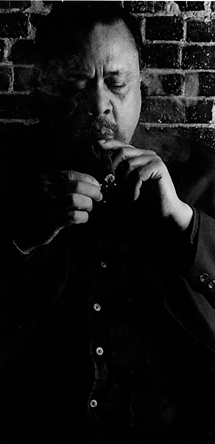Lou Jones; The World Of Jazz Page 2
 |
|
|
And then there was Dizzy Gillespie, who Jones caught at the gym doing his 100 pushups that he said kept his diaphragm in shape so he could pump out the sound of his trumpet.
A dye coupler print (the only color in the show) of Gato Barbieri catches my eye. He stands lighting his cigarette at the entrance to a church. Wearing a black coat and hat, a red scarf that frames his face, it is a marvelous image that has been selected as one of the photographs for a new book by Deborah Willis.
Each photograph has a story and I'll let Jones tell you the one about Charlie Mingus: "Charlie Mingus was an amazing genius, highly thought of as a musician," Jones says. "When he showed up in Boston I dogged him for a photo session and he finally said okay, I could call him at his hotel tomorrow and he would arrange the time.
"Figuring he was probably out all night, I didn't call until 11 in the morning and the phone rang and rang. Finally a gruff voice answered--`What!' "`Mr. Mingus,' I said, `I'm the photographer you talked to last night...' `Call me back!' Two hours later, ring--ring--ring...I called him back three or four times and he finally told me to come over and pick him up. Since I had practically no money I walked all the way over to his hotel and waited for him to get ready. Then I took the only money I had and got him into a cab.
"My studio was on the fourth floor and this guy weighed about 300 lbs. He was not happy! On the second flight up he menacingly asked, `You got no elevator?'
"After he finally got up to the studio he sat down and lit a cigar and I thought I was going to have this enriching afternoon trading stories with one of the great jazz musicians of all times and we were going to become bosom buddies. He was so mad at my waking him up, then making him walk up four stories he never said a word to me. I was doing cartwheels, telling jokes--he was there for three hours--not a word!
"Five or six years later I realized that he owed me absolutely nothing and he was giving me everything. Mingus taught me a big lesson, a lesson I brought to bear when I was photographing CEOs or even royalty. I owe him.
"I was trying to show my clients I had the ability to do this kind of work and in a different way. Here are musicians who have figured out how they could survive doing what they love to do and maybe I could, too."
Much time went by before Jones' jazz photographs were appreciated. He put them away and they were reborn many years later when art directors and collectors began to notice them. The musician series took on a life of its own and has become one of his most outstanding bodies of work.
Assignments poured in from magazines like The Phoenix and Boston After Dark where an especially sensitive portrait of Frank Sinatra's son graces the page.
The long gap of time when Jones let his music series lapse came to life with a new wave of people. Now he photographs musicians like Josh Redman--almost impossible to reach. "There's a big difference in the way I photograph now," Jones says. "In 2001 I shot Redman at a rehearsal, Dizzy Gillespie in his hotel room. The portraits are a lot more environmental."
One of Jones' favorite subjects was Sun Ra. "That was a huge and important seminal photograph in my career because pound for pound he was on the top 10 list for one of the most bizarre people in this world. This guy was `out to lunch!' And there were about 20 of them--it was like a Galactic melee--they were all dressed up with things coming out of their hair, under their arms, their feet--you did not miss it when Sun Ra was in town."
And Jones loved his music! When he heard that Sun Ra would be at a friend's studio at six in the morning, he was right there to grab his picture.
Jones is not always so lucky. Often he was put off with "the next time I'm in town" reply and would confront them with, "Remember me?" And some did. In one case Jones recalls how he sat in the same seat right up front every night until one poor musician got tired of looking at him and let him shoot three frames.
Things change and today I stand beside Jones as he gazes around, looking at his work. "It's amazing," he says. "They're all mine."
To learn more about Lou Jones, visit his website at: www.fotojones.com.
- Log in or register to post comments

































